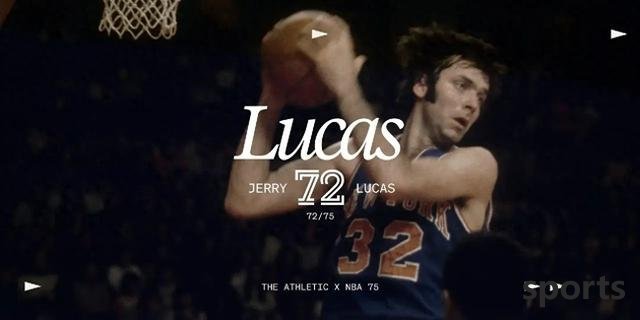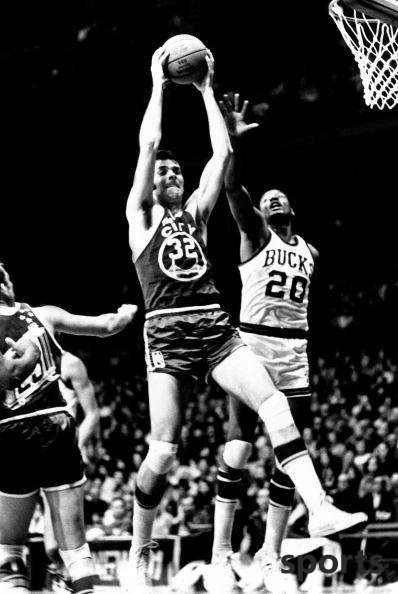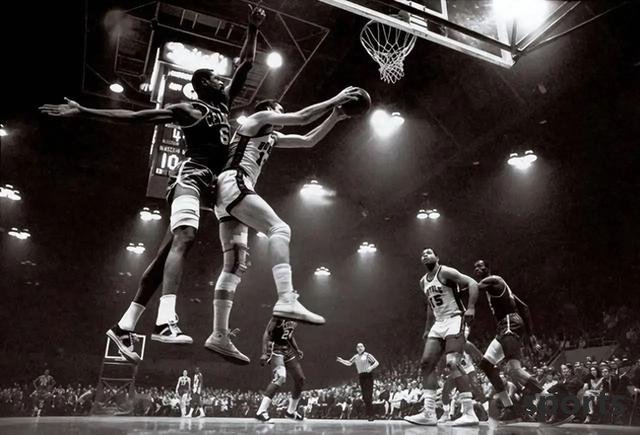"Mr. Memory" Jerry Lucas, TA s rated NBA 75 Big 72
Jerry Lucas' first encounter with basketball is like an undry watercolor painting, with the unique recklessness and clarity of children. In the fourth year, the sunshine in Middletown, Ohio cut across the playground in a diagonal manner. He joined the school team with only sixth graders. Most of the time, he just sat on the sidelines, watching the shoes rub the patterns on the ground, and listening to the blunt sound of the basketball hitting the basket. Until the last 15 seconds of the final game of the season, the coach waved at him. "That 15 seconds were like a bolt of lightning, splitting my future life. " Lucas said to him later. The moment his fingertips touched the ball skin, the rough grainy feeling mixed with the sound of heartbeat crashed into his chest - he suddenly wanted to turn every shot into a carefully designed poem, wanting to entangle his name and basketball forever. After the season ended, the stubborn boy began to create his own grammar in the empty arena. He disassembled the shot into three syllables: D.A.D., direction (Direction), arc (Arc), and distance (Distance). 5,000 shots a day are not mechanical repetitions, but practice brushstrokes on the canvas - he will stare at the basket and imagine the scale of the clock, aim at the inside of the 3 o'clock position 25 times, brush the edge of 11 o'clock 25 times, and even deliberately shoot off, watching the trajectory of the ball popping up on the rebound, and recording the angle of each fall like a star-like study. "I'm always asking why. " Lucas said. The moment the ball left his fingertips, he could already predict its fate. This almost psychic intuition later became his password to run rampant in the rebounding area. Middletown's public stadium has witnessed his obsession: he gestured to the air in the morning light, and was driven away by the old man who was driving away in the twilight. The holes ground from his sneakers could be stuffed into coins, but the calluses in his palms became thicker and thicker, like parchment engraved with formulas. No one has taught him how to get a rebound, just like no one expected that this self-taught boy would become the artist who knows the most about the landing of the ball in NBA history. In his 11-year career, he has been wearing the jerseys of the Royals, Warriors, and Knicks. Behind the number of 15.6 rebounds per game is the science of turning rebounds into accurate calculations: the moment the opponent shoots, he has calculated the parabola of the ball, and his footsteps move like a compass draw an arc, and he can always appear at the most important position. When he won the Best Rookie Trophy in 1964, people only saw the data, but did not understand his notebook for studying opponent's shooting hotmap before the game. When he won the championship with the Knicks in 1973, his teammates were amazed that he always got key rebounds in the melee, but he didn't know that he had painted the landing point of each shot as a map when he was in college. He is the only power forward in NBA history to grab 40 rebounds in a single game, and is also one of the only four players to average "20+20" per game in a single season. But what is more touching than these cold records is his out of place: when other stars are addicted to the scoring feast, he is studying how to get every pass around the defender's fingertips; when the coach emphasizes physical confrontation, he draws the rebound angle of the rebound in his notebook. After being "studyed" against Bob Petit in the rookie season, he did not practice his strength wildly, but dismantled Petit's 100 turn around on the videotape. Finally, he took a 23-point and 17-rebound answer sheet to complete the transformation from an apprentice to a master when he was revenge in the regular season. Even the All-Star Game has become his unique footnote. In the locker room in Boston in 1964, when other players were nervous about labor-management negotiations, he stared at the tactical board and was distracted - not worried about the game, but thought: What sentence structure would it be if the five people on the field were spelled into words as letters? The All-Star Game that almost miscarried finally went on as usual, but Lucas had already dismantled the basketball into a more free expression in his heart. His rebellion never showed its dew, but it always existed. He was selected by the Royals in high school with a regional draft pick, but he refused a sports scholarship and entered Ohio State with academic performance; the ABL League's Cleveland Peppers team offered $40,000 to poach him, 10,000 more than the NBA. He signed, but returned calmly after the league was disbanded - money was never his coordinate, basketball itself is. But basketball is only the first half of his life after all. In the fourth grade, the teacher used "H.O.M.E.S" (the first letter of the Great Lakes) to help students memorize, and fell into his heart like a seed: What if all knowledge can become a touchable image? This idea was like a vine tangling his entire career. On the day of retirement, the 34-year-old did not miss the spotlight, but walked into the library with a stack of educational works. The later stories sound like legends: He spent ten years reading hundreds of textbooks, creating a system of teaching with images and songs, designing the reading planet and the math planet for the education website "The Universe of Doctor of Memory" to compose music for each word, and ask the artist to draw illustrations. The concentration that has been honed on the basketball court is now used to polish the letter shapes in 3D animations; the patience of studying rebounding trajectories has become the persistence of scrutinizing the rhymes of children's songs. "Basketball is my canvas, and education is my mission." When Lucas said this, the light in his eyes was as bright as when he was practicing at Middletown Stadium. His website is about to be launched, 200 teaching songs are waiting on the server, and the letters in the 3D image are dancing - this is not an educational project, it is clearly a cross-border creation completed by an old-school idealist in his lifetime. People remember him as a rebounder, and he was a champion, but what he cared more about was a child remembering the smile of the words spelling because of his song. Just like when he shook hands with the first astronaut Gagarin in Moscow, he was not thinking about "I met the hero", but "If space knowledge is turned into children's songs, will the children love learning more"? "I played basketball for 11 years, but I spent my whole life doing education. " Lucas sat in front of a desk full of manuscripts. The sunlight outside the window was no different from the one at Middletown Stadium.. His life was never an either-or choice, but with the same passion, he drew the same circle in different fields - the seeds planted by the fourth-grade boy on the court eventually grew into a forest that protects more people. Career statistics: Games: 829 games, averaging 17.0 points, 15.6 rebounds, 3.3 assists, shooting percentage of 49.9%, free throw percentage of 78.3%, winning contribution value of 98.4, efficiency value of 18.9 Honors: 1964 Rookie of the Year; Five NBA All-Stars; Seven All-Stars; 1973 NBA Championship; Two Hall of Fame: As a player in 1980, with the 1960 Olympic Team in 2010; NBA 50 Superstar in 1996; NBA 75 Superstar in 2021



- Recent Posts
-
- Nuggets new inside player: Ev
- Which NBA team is more suitabl
- From "Double Loss Questioning"
- Three news: Knicks coach is co
- Durant fights with netizens ag
- Congratulations to Lin Wei! He
- The Los Angeles Clippers main
- Yang Hansen s joint trial trai
- NBA Finals Preview | The Thund
- Curry defeated the Rockets in
- Hot Posts
-
- Yang Hansen tried out the Warr
- How strong is the strongest hi
- Looking forward! 2025-2026 NBA
- NBA rumor: Kevin Durant believ
- Anthony is rated as the strong
- Data analysis: Pacers 2-1 Thun
- Replica Legend, Thunder Alexan
- NBA Summer United: Yang Hansen
- Yang Hansen s rookie contract
- Magic vs. Free throws: Hallibu
- Durant is destined to join the
- There are good and bad! Team m
- Which NBA team is more suitabl
- NBA character Alexander: The T
- Hit 10+4+5+3! Yang Hansen made
- Behind SGA’s Give Up 100 milli
- After Westbrook jumped out of
- The NBA playoff division final
- After Bill reached a buyout, t
- 2025 Rookie Observation (20):
- search
-
- Links
-
